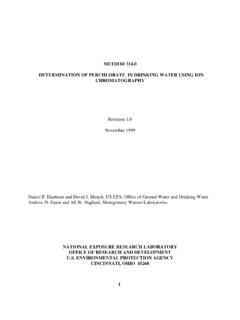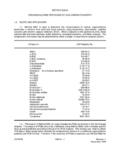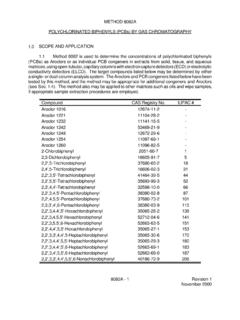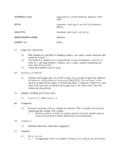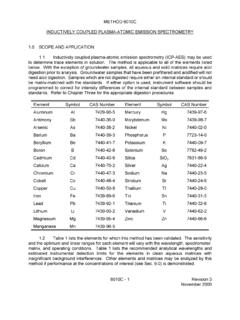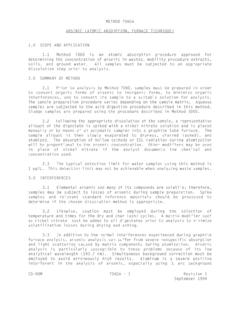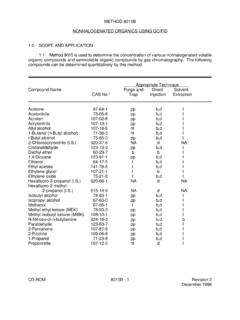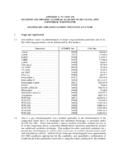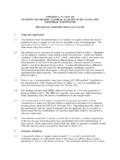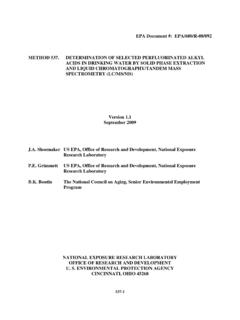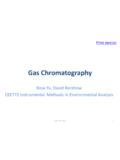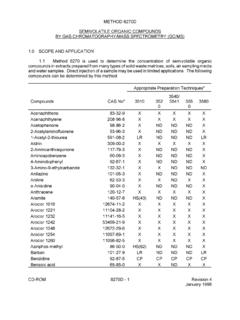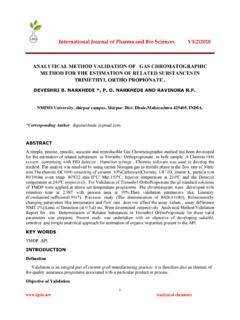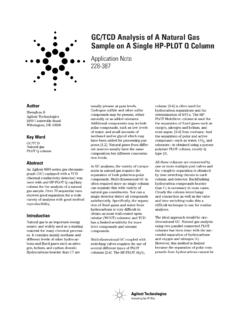Transcription of METHOD 8240B VOLATILE ORGANIC …
1 METHOD 8240B . VOLATILE ORGANIC COMPOUNDS BY GAS chromatography /MASS SPECTROMETRY (GC/MS). SCOPE AND APPLICATION. METHOD 8240 is used to determine VOLATILE ORGANIC compounds in a variety of solid waste matrices. This METHOD is applicable to nearly all types of samples, regardless of water content, including ground water, aqueous sludges, caustic liquors, acid liquors, waste solvents, oily wastes, mousses, tars, fibrous wastes, polymeric emulsions, filter cakes, spent carbons, spent catalysts, soils, and sediments. The following compounds can be determined by this METHOD : _____. Appropriate Technique Direct Analyte CAS Purge-and-Trap Injection Acetone 67-64-1 pp a Acetonitrile 75-05-8 pp a Acrolein (Propenal) 107-02-8 pp a Acrylonitrile 107-13-1 pp a Allyl alcohol 107-18-6 pp a Allyl chloride 107-05-1 a a Benzene 71-43-2 a a Benzyl chloride 100-44-7 pp a Bromoacetone 598-31-2 pp a Bromochloromethane ( ) 74-97-5 a a Bromodichloromethane 75-27-4 a a 4-Bromofluorobenzene (surr.)
2 460-00-4 a a Bromoform 75-25-2 a a Bromomethane 74-83-9 a a 2-Butanone (MEK) 78-93-3 pp a Carbon disulfide 75-15-0 pp a Carbon tetrachloride 56-23-5 a a Chloral hydrate 302-17-0 pp a Chlorobenzene 108-90-7 a a Chlorobenzene-d5 ( ) 3114-55-4 a a Chlorodibromomethane 124-48-1 a a Chloroethane 75-00-3 a a 2-Chloroethanol 107-07-3 pp a bis-(2-Chloroethyl) sulfide 505-60-2 pp a 2-Chloroethyl vinyl ether 110-75-8 a a Chloroform 67-66-3 a a Chloromethane 74-87-3 a a Chloroprene 126-99-8 a pc 3-Chloropropionitrile 542-76-7 ND pc 1,2-Dibromo-3-chloropropane 96-12-8 pp a 1,2-Dibromoethane 106-93-4 a a CD-ROM 8240B - 1 Revision 2. September 1994. _____. Appropriate Technique Direct Analyte CAS Purge-and-Trap Injection Dibromomethane 74-95-3 a a 1,4-Dichloro-2-butene 764-41-0 pp a Dichlorodifluoromethane 75-71-8 a a 1,1-Dichloroethane 75-34-3 a a 1,2-Dichloroethane 107-06-2 a a 1,2-Dichloroethane-d4(surr.)
3 107-06-2 a a 1,1-Dichloroethene 75-35-4 a a trans-1,2-Dichloroethene 156-60-5 a a 1,2-Dichloropropane 78-87-5 a a 1,3-Dichloro-2-propanol 96-23-1 pp a cis-1,3-Dichloropropene 10061-01-5 a a trans-1,3-Dichloropropene 10061-02-6 a a 1,2,3,4-Diepoxybutane 1464-53-5 a a 1,4-Difluorobenzene ( ) 540-36-3 a a 1,4-Dioxane 123-91-1 pp a Epichlorohydrin 106-89-8 i a Ethanol 64-17-5 i a Ethylbenzene 100-41-4 a a Ethylene oxide 75-21-8 pp a Ethyl methacrylate 97-63-2 a a 2-Hexanone 591-78-6 pp a 2-Hydroxypropionitrile 78-97-7 ND pc Iodomethane 74-88-4 a a Isobutyl alcohol 78-83-1 pp a Malononitrile 109-77-3 pp a Methacrylonitrile 126-98-7 pp a Methylene chloride 75-09-2 a a Methyl iodide 74-88-4 a a Methyl methacrylate 80-62-6 a a 4-Methyl-2-pentanone 108-10-1 pp a Pentachloroethane 76-01-7 i pc 2-Picoline 109-06-8 pp a Propargyl alcohol 107-19-7 pp a -Propiolactone 57-57-8 pp a Propionitrile 107-12-0 pp a n-Propylamine 107-10-8 a a Pyridine 110-86-1 i a Styrene 100-42-5 a a 1,1,1,2-Tetrachloroethane 630-20-6 a a 1,1,2,2-Tetrachloroethane 79-34-5 a a Tetrachloroethene 127-18-4 a a Toluene 108-88-3 a a Toluene-d8 (surr.)
4 2037-26-5 a a 1,1,1-Trichloroethane 71-55-6 a a 1,1,2-Trichloroethane 79-00-5 a a Trichloroethene 79-01-6 a a Trichlorofluoromethane 75-69-4 a a CD-ROM 8240B - 2 Revision 2. September 1994. _____. Appropriate Technique Direct Analyte CAS Purge-and-Trap Injection 1,2,3-Trichloropropane 96-18-4 a a Vinyl acetate 108-05-4 a a Vinyl chloride 75-01-4 a a Xylene (Total) 1330-20-7 a a a Adequate response by this technique. b Chemical Abstract Services Registry Number. pp Poor purging efficiency resulting in high EQLs. i Inappropriate technique for this analyte. pc Poor chromatographic behavior. surr Surrogate Internal Standard ND Not determined METHOD 8240 can be used to quantitate most VOLATILE ORGANIC compounds that have boiling points below 200oC and that are insoluble or slightly soluble in water. VOLATILE water-soluble compounds can be included in this analytical technique.
5 However, for the more soluble compounds, quantitation limits are approximately ten times higher because of poor purging efficiency. The METHOD is also limited to compounds that elute as sharp peaks from a GC. column packed with graphitized carbon lightly coated with a carbowax. Such compounds include low molecular weight halogenated hydrocarbons, aromatics, ketones, nitriles, acetates, acrylates, ethers, and sulfides. See Table 1 for a list of compounds, retention times, and their characteristic ions that have been evaluated on a purge-and-trap GC/MS system. The estimated quantitation limit (EQL) of METHOD 8240 for an individual compound is approximately 5 g/kg (wet weight) for soil/sediment samples, mg/kg (wet weight) for wastes, and 5 g/L for ground water (see Table 2). EQLs will be proportionately higher for sample extracts and samples that require dilution or reduced sample size to avoid saturation of the detector.
6 This METHOD is restricted to use by, or under the supervision of, analysts experienced in the use of purge-and-trap systems and gas chromatograph/mass spectrometers, and skilled in the interpretation of mass spectra and their use as a quantitative tool. To increase purging efficiencies of acrylonitrile and acrolein, refer to methods 5030 and 8030 for proper purge-and-trap conditions. SUMMARY OF METHOD . The VOLATILE compounds are introduced into the gas chromatograph by the purge-and-trap METHOD or by direct injection (in limited applications). The CD-ROM 8240B - 3 Revision 2. September 1994. components are separated via the gas chromatograph and detected using a mass spectrometer, which is used to provide both qualitative and quantitative information. The chromatographic conditions, as well as typical mass spectrometer operating parameters, are given.
7 If the above sample introduction techniques are not applicable, a portion of the sample is dispersed in methanol to dissolve the VOLATILE ORGANIC constituents. A portion of the methanolic solution is combined with ORGANIC - free reagent water in a specially designed purging chamber. It is then analyzed by purge-and-trap GC/MS following the normal water METHOD . The purge-and-trap process - An inert gas is bubbled through the solution at ambient temperature, and the VOLATILE components are efficiently transferred from the aqueous phase to the vapor phase. The vapor is swept through a sorbent column where the VOLATILE components are trapped. After purging is completed, the sorbent column is heated and backflushed with inert gas to desorb the components onto a gas chromatographic column. The gas chromatographic column is heated to elute the components, which are detected with a mass spectrometer.
8 INTERFERENCES. Interferences purged or coextracted from the samples will vary considerably from source to source, depending upon the particular sample or extract being tested. The analytical system, however, should be checked to ensure freedom from interferences, under the analysis conditions, by analyzing METHOD blanks. Samples can be contaminated by diffusion of VOLATILE organics (particularly methylene chloride and fluorocarbons) through the septum seal into the sample during shipment and storage. A trip blank, prepared from ORGANIC -free reagent water and carried through the sampling and handling protocol, can serve as a check on such contamination. Cross contamination can occur whenever high-concentration and low- concentration samples are analyzed sequentially. Whenever an unusually concentrated sample is analyzed, it should be followed by the analysis of ORGANIC -free reagent water to check for cross contamination.
9 The purge-and-trap system may require extensive bake-out and cleaning after a high-concentration sample. The laboratory where VOLATILE analysis is performed should be completely free of solvents. Impurities in the purge gas and from ORGANIC compounds out-gassing from the plumbing ahead of the trap account for the majority of contamination problems. The analytical system must be demonstrated to be free from contamination under the conditions of the analysis by running calibration and reagent blanks. The use of non-TFE plastic coating, non-TFE thread sealants, or flow controllers with rubber components in the purging device should be avoided. CD-ROM 8240B - 4 Revision 2. September 1994. APPARATUS AND MATERIALS. Microsyringes - 10 L, 25 L, 100 L, 250 L, 500 L, and 1,000 L. These syringes should be equipped with a 20 gauge ( in. ID) needle having a length sufficient to extend from the sample inlet to within 1 cm of the glass frit in the purging device.
10 The needle length will depend upon the dimensions of the purging device employed. Syringe valve - Two-way, with Luer ends (three each), if applicable to the purging device. Syringe - 5 mL, gas-tight with shutoff valve. Balances - Analytical, g, and top-loading, g. Glass scintillation vials - 20 mL, with screw caps and Teflon liners or glass culture tubes with a screw cap and Teflon liner. Volumetric flasks, Class A - 10 mL and 100 mL, with ground-glass stoppers. Vials - 2 mL, for GC autosampler. Spatula - Stainless steel. Disposable pipets - Pasteur. Heater or heated oil bath - Should be capable of maintaining the purging chamber to within 1oC over the temperature range of ambient to 100oC. Purge-and-trap device - The purge-and-trap device consists of three separate pieces of equipment: the sample purger, the trap, and the desorber. Several complete devices are commercially available.
